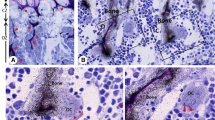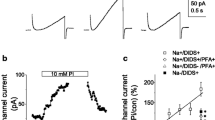Summary
The effect of prostaglandin E2 (PGE2) on the kinetic of bone resorptionin vitro was assessed by following the release of minerals and degradation of matrix in cultured mouse calvarial bones. PGE2 (1 and 3 μmol/liter) caused an initial inhibition of the release of45Ca, stable calcium, and inorganic phosphate from unstimulated calvarial bones. The effect was transient and after 24 and 48 hours the release of45Ca, stable calcium, and inorganic phosphate from PGE2-treated bones was enhanced. 0.3 μmol/liter of PGE2 stimulated the release of45Ca after 24 hours, but at this concentration no initial inhibition was observed. The initial inhibitory effect of PGE2 (1 μmol/liter) could be further increased by three structurally different inhibitors of cyclic AMP breakdown. PGE2 (1 μmol/liter) caused not only an initial inhibition of mineral release but also an initial inhibition of matrix degradation, as assessed by the release of3H from [3H]-proline labeled bones. In addition, PGE2 (3 μmol/liter), in the presence of the phosphodiesterase inhibitor isobutylmethylxanthine, caused a rapid (6 hours) inhibition of the release of the lysosomal enzymes β-glucuronidase and β-N-acetyl-glucosaminidase, without affecting the release of the cytosolic enzyme lactate dehydrogenase. Similar specific initial inhibition of lysosomal enzyme release was also seen in the presence of calcitonin and dibutyryl cyclic AMP, but not in the presence of parathyroid hormone (PTH). Neither PGE2 nor the phosphodiesterase inhibitors rolipram and Ro 20.1724, could inhibit the initial stages of PTH-induced45Ca release. Nor did PGE2 inhibit the stimulation of radioactive calcium mobilization induced by 1α(OH)-vitamin D3. Enhancement of cyclic AMP formation by forskolin, choleratoxin, and dibutyryl cyclic AMP in unstimulated bones resulted in an initial reduction of45Ca release (6 hours) followed by a delayed stimulation (96 hours). These data indicate that PGE2 has the capacity to reduce the activity of unstimulated, preexisting osteoclasts by a cyclic AMP-dependent process.
Similar content being viewed by others
References
Raisz LG, Dietrich JW, Simmons HA, Seyberth HW, Hubbard W, Oates JA (1977) Effect of prostaglandin endoperoxides and metabolites on bone resorption in vitro. Nature 267:532–534
Tashjian Jr AH, Tice JE, Sides K (1977) Biological activities of prostaglandin analogues and metabolites on bone in organ culture. Nature 266:645–647
Raisz LG, Martin TJ (1984) Prostaglandins in bone and mineral metabolism. In: Peck WA, (ed) Bone and mineral research. Annual 2, Elsevier, Amsterdam, pp 286–310
Atkins D, Martin TJ (1977) Rat osteogenic sarcoma cells: effects of some prostaglandins, their metabolites and analogues on cyclic AMP production. Prostaglandins 13:861–871
Crawford A, Atkins D, Martin TJ (1978) Rat osteogenic sarcoma cells: comparison of the effects of prostaglandins E1, E2, I2 (prostacyklin), 6-keto F1 and thromboxane B2 on cyclic AMP production and adenylate cyclase activity. Biochem Biophys Res Commun 82:1195–1201
Partridge NC, Kemp BE, Veroni MC, Martin TJ (1981) Activation of adenosine 3′, 5′-monophosphate-dependent protein kinase in normal and malignant bone cells by parathyroid hormone, prostaglandin E2 and prostacyklin. Endocrinology 108:220–225
Vaes G (1968) Parathyroid hormone-like action of N6-2′-O-dibutyryladenosine-3′,5′-(cyclic)-monophosphate on bone explants in tissue culture. Nature 219:939–940
Klein DC, Raisz LG (1971) Role of adenosine 3′,5′-monophosphate in the hormonal regulation of bone resorption: studies with cultured fetal rat bone. Endocrinology 89:818–826
Eilon G, Raisz LG (1978) Comparison of the effects of stimulators and inhibitors of resorption on the release of lysosomal enzymes and radioactive calcium from fetal bone in organ culture. Endocrinology 103:1969–1975
Lerner U (1980) The effect of dibutyryl cyclic AMP and PGE2 on lysosomal enzyme release and lactate production in relation to bone resorption in vitro. Acta Physiol Scand 110:123–130
Lerner U, Gustafson GT (1981) Delayed stimulatory effect of cyclic AMP on bone resorption in vitro. Acta Endocrinol 97:281–288
McLeod JF, Raisz LG (1981) Comparison of inhibition of bone resorption and escape with calcitonin and dibutyryl 3′,5′-cyclic adenosine monophosphate. Endocr Res Commun 8:49–59
Herrmann-Erlee MPM, van der Meer JM (1974) The effects of dibutyryl cyclic AMP, aminophylline and propranolol on PTE-induced bone resorption in vitro. Endocrinology 94:424–434
Nagata N, Ono Y, Kimura N (1977) Inhibition by choleratoxin of parathyroid hormone-induced calcium release from bone in culture. Biochem Biophys Res Commun 78:819–826
Lerner U, Fredholm BB, Ransjö M (1984) Transient inhibition on calcium mobilization from cultured mouse calvarial bones by the adenylate cyclase stimulator forskolin. Acta Physiol Scand 120:159–160
Chambers TJ, Ali NN (1983) Inhibition of osteoclastic motility of prostaglandins I2, E1, E2 and 6-oxo-E1. J Pathol 139:383–397
Chambers TJ, McSheehy PMJ, Thompson BM, Fuller K (1985) The effect of calcium-regulating hormones and prostaglandins on bone resorption by osteoclasts disaggregated from neonatal rabbit bones. Endocrinology 116:234–239
Dietrich JW, Goodson JM, Raisz LG (1975) Stimulation of bone resorption by various prostaglandins in organ culture. Prostaglandins 10:231–240
Lerner U, Fredholm BB, Hänström L (1985) Diphenylhydantoin inhibits parathyroid hormone and prostaglandin E2-stimulated bone resorption in mouse calvaria without affecting cyclic AMP formation. J Oral Pathol 14:644–653
Lerner U (1980) Indomethacin inhibits bone resorption and lysosomal enzyme release from bone in organ culture. Scand J Rheumatol 9:149–156
Lerner U, Fredholm BB (1985) Prostaglandin E2 and 2-chloroadenosine act in concert to stimulate bone resorption in cultured murine calvarial bones. Biochem Pharmacol 34:937–940
Reynolds JJ (1976) Organ cultures of bone: studies on the physiology and pathology of resorption. In: Balls M, Monnickendam M (eds) Organ culture in biomedical research. Cambridge, University Press, pp 355–366
Willis JB (1970) Atomic absorption spectrometry. In: Mavrodineanu R (ed) Analytic flame spectroscopy, Philips Technical Library, Eindhoven, pp 525–594
Chen PS, Toribara TY, Warner H (1956) Microdetermination of phosphorus. Anal Chem 28:1756–1758
Brand JS, Raisz LG (1972) Effects of thyrocalcitonin and phosphate ion on the parathyroid hormone-stimulated resorption of bone. Endocrinology 90:479–487
Vaes G, Jacques P (1965) Studies on bone enzymes. The assay of acid hydrolases and other enzymes in bone tissue. Biochem J 97:380–388
Wroblewski F, LaDue JS (1955) Lactate dehydrogenase activity in blood. Proc Soc Exp Biol Med 90:210–213
Peck WA, Klahr S (1979) Cyclic nucleotides in bone and mineral metabolism. Adv Cyclic Nucl Res 11:89–130
Conaway HH, Diez LF, Raisz LG (1986) Effects of prostacyklin and prostaglandin E1 (PGE1) on bone resorption in the presence and absence of parathyroid hormone. Calcif Tissue Int 38:130–135
Raisz LG, Niemann I (1967) Early effects of parathyroid hormone and thyrocalcitonin on bone in organ culture. Nature 214:486–487
Reynolds JJ, Dingle JT (1970) A sensitive method for studying the induction and inhibition of bone resorption. Calcif Tissue Res 4:339–349
Nefussi J-R, Baron R (1985) PGE2 stimulates both resorption and formation of bone in vitro: differential responses of the periosteum and the endosteum in fetal rat long bone cultures. Anat Rec 211:9–16
Walenga RW, Bergstrom W (1985) Stimulation of calcium uptake in rat calvaria by prostacyklin. Prostaglandins 29:191–202
Lerner U, Ransjö M, Fredholm BB (in press) Comparative study of the effects of cyclic nucleotide phosphodiesterase inhibitors on bone resorption and cyclic AMP formation in vitro. Biochem Pharmacol
Wong GL (in press) Skeletal effects of PTH. In: Peck WA (ed) Bone and mineral research. Annual 4.
Tashjian Jr AH, Wright DR, Ivey JL, Pont A (1978) Calcitonin binding sites in bone: relationships to biological response and “escape”. Recent Prog Horm Res 34:285–335
Rao LG, Heersche JNM, Marchule LL, Sturtridge W (1981) Immunohistochemical demonstration of calcitonin binding to specific cell types in fixed rat bone tissue. Endocrinology 108:1972–1978
Nicholsson GC, Moseley JM, Martin TJ (in press) Abundant calcitonin receptors in rat osteoclasts. Abstract presented at The First Meeting on Cytokines in Bone and Cartilage in Davos 1985. Calcif Tissue Int
Wener JA, Gorton SJ, Raisz LG (1972) Escape from inhibition of resorption in cultures of fetal bone treated with calcitonin and parathyroid hormone. Endocrinology 90:752–759
Vaes G (1980) Collagenase, lysosomes and osteoclastic bone resorption. In: Wolley DE, Evanson JM (eds) Collagenase in normal and pathological connective tissues. John Wiley and Sons, Chichester, pp 185–207
Lerner U (1980) Relationship between bone resorption and lysosomal enzyme release as demonstrated by the effect of 1α(OH)-vitamin-D3 in an organ culture system. Biochim Biophys Acta 632:204–213
Author information
Authors and Affiliations
Rights and permissions
About this article
Cite this article
Lerner, U.H., Ransjö, M. & Ljunggren, Ö. Prostaglandin E2 causes a transient inhibition of mineral mobilization, matrix degradation, and lysosomal enzyme release from mouse calvarial bonesIn Vitro . Calcif Tissue Int 40, 323–331 (1987). https://doi.org/10.1007/BF02556694
Received:
Revised:
Issue Date:
DOI: https://doi.org/10.1007/BF02556694




